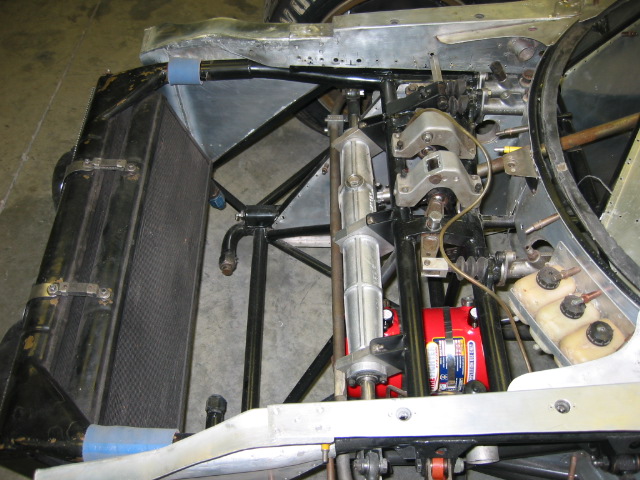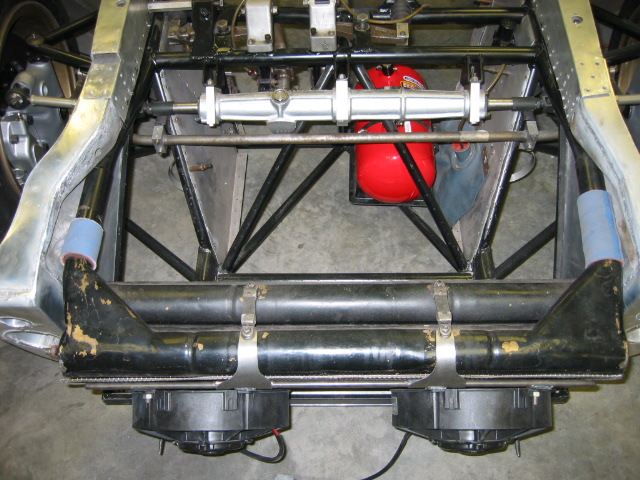| Author | Message | ||
| L. Wayne Ausbrooks (Lwausbrooks)
Intermediate Member Username: Lwausbrooks Post Number: 1185 Registered: 8-2002 |
Jim, you've got mail. | ||
| James Glickenhaus (Napolis)
Member Username: Napolis Post Number: 756 Registered: 10-2002 |
JRV You may be right. The early P3 oil coolers were a strange unit of three long coils tied together in a triangular shape. This oil cooler didn't work too well. On the P4 they went to a wide square oil cooler mounted behind the water rad. Your point about the cooling effect of FI nozzels is interesting. (On my Maser there is a 2 stage fuel pump. When the ECM senses low fuel PSI due to a low fuel level it switches on the second stage. The noise the second stage makes is pretty loud and resonates in the near empty tank. My MK-IV has aux pumps that switch on when you go to the reserve fuel tanks. They sound like a heuy taking off.) Best Jim   | ||
| James Glickenhaus (Napolis)
Member Username: Napolis Post Number: 755 Registered: 10-2002 |
In 1967 I don't think they chilled the fuel. Some of the Corvette guys did pack the engine with ice. You weren't allowed to add water or oil until the car had gone a certain distance. If you sprung a leak you had to improvise until you were allowed to add water. | ||
| JRV (Jrvall)
Intermediate Member Username: Jrvall Post Number: 1093 Registered: 11-2002 |
>>JRV Sal said my TR AC high pressure line was also run like like the one's you described. James << Mr. G, what this means to me is that Ferrari is not worried about Fuel Temp, which is why I gave the modern example (like Sal) of using the cooler fuel to help with temp issues in other areas. At 120 PSI the fuel will cool itself (like freon) when it's sprayed thru the orifice of the injectors. Atomization will be handled by Nozzle spray pattern & pressure, turbulance & velocity and port temp. Sounds like this may have been an early attempt at reducing frontal area drag possibly by the use of a smaller cooler or just a little extra insurance for oil temp control ? Interesting. | ||
| Paul Wehmer (Pwehmer)
Junior Member Username: Pwehmer Post Number: 97 Registered: 10-2002 |
Perhaps the Ferrari team chilled thier fuel down in the pits. This would increase the density of the fuel allowing the car to go farther on a tank. Getting a 1-2% increased charge of fuel could make a difference in an endurance race. Warming the fuel would help the vaporization. Also it would help keep the fuel temp constant. The simple FI system wouldn't take the changes in fuel density due to temperture changes into consideration. OK-just a theory I had. | ||
| James Glickenhaus (Napolis)
Member Username: Napolis Post Number: 744 Registered: 10-2002 |
JRV Sal said my TR AC high pressure line was also run like like the one's you described. James From Sal's description it sounds like the oil line runs nestled within the gas balance tube. When I next see the car I'll let you know. Today I looked at my Duesenberg which has an exhaust riser that seems to heat the carb. Interesting. Best Jim | ||
| James Selevan (Jselevan)
Member Username: Jselevan Post Number: 433 Registered: 6-2002 |
Two observations: 1) - "...oil lines run in contact..." If they merely sit next to each other, despite "touching" there will be very little heat transfer. If the oil line runs through the fuel line, thereby being immersed, then the fuel will draw heat. 2) It is not uncommon to heat fuel before sending it to carburetors or injectors. The higher fuel temperature leads to more rapid vaporization, which is a good thing (for obvious reasons). The density of fuel in liquid form - whether hot or cold - is not significantly altered. Once in gaseous state, carburetion or injection flow mechanics will establish the correct air/fuel ratio (14:1). Getting fuel into the gaseous state is key, and warmer fuel gets there faster. Jim S. | ||
| JRV (Jrvall)
Intermediate Member Username: Jrvall Post Number: 1088 Registered: 11-2002 |
I should have mentioned, the early TR's "Saudi Arabia" versions had the High Press. A/C Lines running thru the gas tanks to draw additional heat out of the freon for lower vent temps. Engine Temp control is far more important to horsepower and ability to live than fuel temp. | ||
| JRV (Jrvall)
Intermediate Member Username: Jrvall Post Number: 1087 Registered: 11-2002 |
Makes sense actually, oil temp would be alot more critical imo in racing than 1-2-3-? extra horsepower gained from Fuel Temp..and the horsepower easily traded off or picked back up by keeping the internals of the engine that much cooler and better lubricated. | ||
| '75 308 GT4 (Peter)
Advanced Member Username: Peter Post Number: 2566 Registered: 12-2000 |
Never heard of that before. It is more common to have a heat-exchanger along one of the coolant pipes (a la Dino 206/246 and some early 365 Boxers). | ||
| James Glickenhaus (Napolis)
Member Username: Napolis Post Number: 742 Registered: 10-2002 |
We just determined that the oil lines are run in contact with the alum 3inch gas balancing tube that connects the right and left side fuel cells. Sal thinks this was done to cool the oil using the gas as a heat sink. Remembering that this is a mech fuel injected engine (120 PSI) what do you think? Wouldn't hotter gas produce less power? This seems to be original not something Piper did. Best Jim |